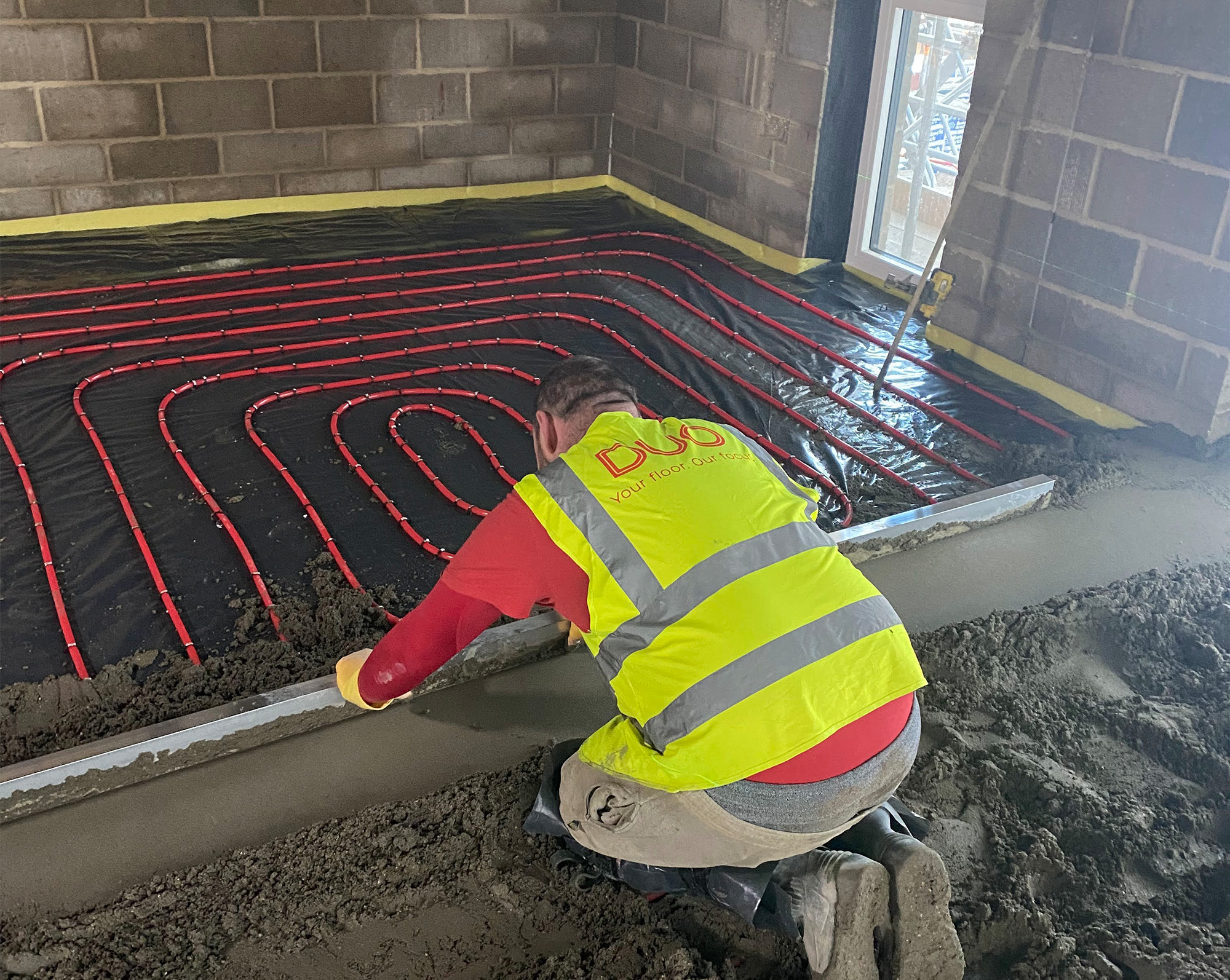Cold floors and rising energy bills can make winter harder than it needs to be. If your home uses underfloor heating, a few simple steps can help you get more warmth without wasting power. Small changes like adjusting thermostat settings, checking insulation, and using timers wisely can improve underfloor heating winter efficiency. This means your system works smarter, not harder when temperatures drop. You don’t need to spend a lot or overhaul your setup to see real savings. This article breaks down clear actions that help your underfloor heating system run better and cost less during the colder months.
Insulate Floors to Lock in Heat
Installing insulation under your flooring helps stop warmth from escaping. Without it, heat moves down into the subfloor instead of rising into the room. This means your system must run longer to reach and keep the right temperature. That uses more power and increases costs.
When you add insulation boards or layers beneath your heating setup, you create a barrier. This layer keeps heat moving upward where it can warm people and surfaces above. It also reduces how much time the system needs to stay on, which improves underfloor heating winter efficiency.
Many homes lose energy through uninsulated floors, especially if they sit above basements or crawl spaces. Even concrete bases absorb heat without proper barriers in place. Insulation stops this transfer by trapping warmth inside living areas. As a result, less energy is needed for comfort during colder months.
Foam boards made for floor systems are one option that works well with electric or water-based designs. These materials resist compression and don’t shift over time, keeping performance steady throughout use. Reflective foil insulation also helps by bouncing radiant heat back toward the surface.
Before laying any heating mats or pipes, check subfloor conditions first. Clean surfaces support better contact between layers and help avoid gaps that let warmth leak out. Secure each piece tightly so no space remains uncovered.
Using floor insulation also shortens how long it takes to feel results after switching on your system. Faster response times mean lower usage overall because rooms warm up quicker and hold steady longer between cycles.
Small changes like adding thermal barriers underfoot can lead to noticeable savings across winter months. Less strain on heaters means fewer repairs later too since systems don’t need to overwork just to maintain indoor comfort levels each day when outdoor temperatures drop.
By focusing on where energy goes before turning up controls, households can manage power use smarter while staying warm indoors during cold seasons without wasteful output from their heating setup.

Optimise Thermostat Settings for Smart Savings
Programmable thermostats help manage heating without wasting energy. Setting a schedule means the system runs only when needed. This avoids heating empty rooms or running the system overnight at full power.
Start by setting lower temperatures during sleeping hours or while away from home. For example, reduce the heat by a few degrees at night and raise it again before morning routines begin. Most programmable devices allow multiple time blocks, so you can match your routine closely.
During weekdays, set the temperature to drop after everyone leaves and rise again shortly before return times. On weekends, adjust based on when people stay in. This approach helps control how much energy is used each day.
Another tip is to avoid frequent manual changes to temperature settings. Constant adjustments make the system overwork, using more power than needed. Stick to a consistent plan that aligns with daily habits.
Use built-in features like “holiday” or “eco” modes if available. These functions keep temperatures low during long absences but prevent freezing pipes or other damage.
Smart thermostats offer remote access through apps. If plans change, you can update timings from your phone instead of leaving systems running all day unnecessarily.
Maintaining underfloor heating winter efficiency depends on steady operation rather than high bursts of heat followed by shutdowns. Gradual warming uses less energy and keeps floors evenly warm over time.
Check thermostat batteries regularly if not hardwired into your home’s power supply. Low battery levels can cause misreadings or failure to follow programmed schedules correctly.
Set reminders every few months to review and tweak existing settings as seasons shift slightly or routines change due to school breaks or job schedules.
Efficient use of controls makes a difference in monthly costs without needing extra equipment or upgrades, only better planning and consistent settings throughout colder months.
Maintain Your System for Peak Performance
Check your underfloor heating system often to keep it working well. Dust, dirt, and debris can build up over time. These block heat transfer and make the system less effective. Cleaning the floor surface and checking for any obstructions helps keep everything running smoothly.
Schedule a full inspection at least once a year. A professional can test valves, pumps, and thermostats to confirm they function properly. If there’s air trapped in the pipes or if fluid levels drop too low, performance drops too. Bleeding the system removes trapped air and helps maintain pressure.
Look out for uneven temperatures across different rooms or zones. This could be a sign of flow issues or blocked circuits. If one area feels cooler than another, it may need recalibration or flushing of the pipework.
Keep thermostats accurate by testing them regularly. If readings drift from actual room temperature, energy use goes up without better comfort in return. Replacing faulty sensors or recalibrating controls makes sure you’re not wasting power.
Insulation also plays a role in how well your setup works. Check that insulation boards under the flooring remain intact and dry. Damaged insulation lets heat escape downwards instead of warming your space.
Frequent maintenance keeps energy use low while helping avoid costly repairs later on. It also supports underfloor heating winter efficiency, especially during colder months when demand is higher.
If you notice strange sounds like gurgling or clicking coming from the floor, don’t ignore them. These noises might mean trapped air or worn-out components that need attention before bigger problems develop.
Always follow manufacturer instructions when cleaning filters or adjusting settings yourself at home. Avoid using harsh chemicals near pipes or control units to prevent damage over time.
A well-maintained system uses less power while keeping indoor temperatures steady throughout winter months without overworking itself daily.

Underfloor Heating Winter Efficiency: Use Floor Coverings Strategically
Picking the right floor surface plays a key role in improving how well your system performs. Some materials let heat pass through faster than others. When using underfloor heating, surfaces like tile and stone help move warmth from the pipes into your room more effectively. These solid materials do not trap heat. Instead, they allow it to rise quickly, helping maintain steady room temperatures.
Carpets and thick rugs can block heat flow. They act as barriers between the heated floor and the air above it. This makes your system use more energy to reach the same level of comfort. If you prefer soft coverings, choose low-tog options designed for heated floors. These options reduce resistance and let more warmth move upward.
Wood flooring varies in how well it works with radiant systems. Engineered wood often handles temperature changes better than solid planks. Always check if a specific product is marked safe for use with floor heating before installing it.
Placement also matters when trying to improve underfloor heating winter efficiency. Avoid placing large furniture without legs directly on top of heated areas for long periods of time. Items that sit flat on the ground can prevent heat from spreading evenly across a room.
If you’re upgrading or choosing new flooring during colder months, consider materials that support thermal transfer instead of blocking it. Even small changes like moving thick mats or replacing dense rugs can make a difference in how much energy your system uses daily.
Keeping an open space above your heating helps air circulate properly throughout the area being warmed by your setup. This reduces strain on your equipment and supports consistent output over time without extra power use.
Every choice made about what goes over a heated floor has an effect on cost and performance through winter months when demand is higher than usual across homes using these systems regularly for comfort indoors.
Maximise Comfort and Cost Savings with Smart Heating Strategies
As winter sets in, taking a proactive approach to your home’s heating system can deliver lasting benefits. By insulating floors, fine-tuning thermostat settings, performing regular maintenance, and using floor coverings wisely, you can significantly improve underfloor heating winter efficiency. These practical steps not only help maintain a warmer home but also reduce unnecessary energy waste, cutting down your bills in the process. Small changes lead to big results when applied consistently. Now is the time to implement these tactics and make the most of your underfloor heating system throughout the colder months.


